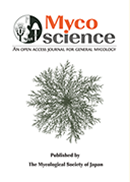Volume 55, Issue 3
Displaying 1-12 of 12 articles from this issue
- |<
- <
- 1
- >
- >|
Short communication
-
2014Volume 55Issue 3 Pages 159-163
Published: 2014
Released on J-STAGE: March 07, 2023
Download PDF (1083K)
Note
-
Analysis of indole compounds from the fruiting bodies and the culture mycelia of Sarcodon imbricatus2014Volume 55Issue 3 Pages 164-167
Published: 2014
Released on J-STAGE: March 07, 2023
Download PDF (344K)
Full paper
-
2014Volume 55Issue 3 Pages 168-176
Published: 2014
Released on J-STAGE: March 07, 2023
Download PDF (1948K)
Short communication
-
2014Volume 55Issue 3 Pages 177-182
Published: 2014
Released on J-STAGE: March 07, 2023
Download PDF (1583K)
Full paper
-
2014Volume 55Issue 3 Pages 183-189
Published: 2014
Released on J-STAGE: March 07, 2023
Download PDF (719K) -
2014Volume 55Issue 3 Pages 190-195
Published: 2014
Released on J-STAGE: March 07, 2023
Download PDF (1189K) -
2014Volume 55Issue 3 Pages 196-212
Published: 2014
Released on J-STAGE: March 07, 2023
Download PDF (5251K) -
2014Volume 55Issue 3 Pages 213-220
Published: 2014
Released on J-STAGE: March 07, 2023
Download PDF (1725K) -
2014Volume 55Issue 3 Pages 221-226
Published: 2014
Released on J-STAGE: March 07, 2023
Download PDF (1068K)
Note
-
2014Volume 55Issue 3 Pages 227-230
Published: 2014
Released on J-STAGE: March 07, 2023
Download PDF (1577K)
Full paper
-
2014Volume 55Issue 3 Pages 231-239
Published: 2014
Released on J-STAGE: March 07, 2023
Download PDF (1105K)
Erratum
-
2014Volume 55Issue 3 Pages 240
Published: 2014
Released on J-STAGE: March 07, 2023
Download PDF (170K)
- |<
- <
- 1
- >
- >|
